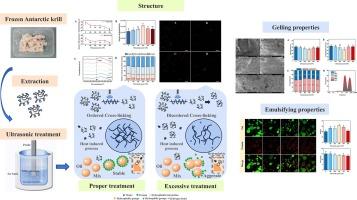Ultrasound treatment improved gelling and emulsifying properties of myofibrillar proteins from Antarctic krill (Euphausia superba)
IF 8.7
1区 化学
Q1 ACOUSTICS
引用次数: 0
Abstract
Antarctic krill is a promising source of marine proteins with abundant biomass and excellent nutritional profile, but has poor technological properties. Ultrasonic treatment at power levels of 0, 100, 200, 300, 400 and 500 W was applied to improve the technological properties of Antarctic krill meat, and the changes in physicochemical properties of myofibrillar proteins (MPs) were investigated. The results indicated that proper ultrasonic treatment significantly improved the gelling properties of Antarctic krill meat, in terms of a more uniform and stable gel texture and better water holding capacity, which were related to better cross-linking of MPs. Ultrasonic treatment promoted the conversion of MPs’ secondary structures from α-helix and random coil to β-sheet and β-turn, thereby making the molecular structure soft and loose. In addition, at tertiary structure level, ultrasonic treatment exposed the hydrophobic groups and sulfhydryl groups within MPs, thereby improving the emulsifying properties by changing the intermolecular interactions and interface properties. Furthermore, the particle size of MPs decreased and exhibited a more uniform distribution, aligning with the enhanced interactions observed between MPs and oil. These results provide an insight into the efficient development of Antarctic krill by elucidating how the ultrasonic treatment improves the gelling and emulsifying properties based on structure modulation of myofibrillar proteins.

超声波处理改善了南极磷虾(Euphausia superba)肌纤维蛋白的胶凝和乳化特性
南极磷虾具有丰富的生物量和优异的营养成分,是一种前景广阔的海洋蛋白质来源,但其工艺性能较差。为了改善南极磷虾肉的工艺性能,研究人员采用了功率分别为 0、100、200、300、400 和 500 W 的超声波处理方法,并研究了肌纤维蛋白(MPs)理化性质的变化。结果表明,适当的超声波处理能明显改善南极磷虾肉的胶凝特性,使凝胶质地更均匀稳定,持水性更好,这与 MPs 的交联效果更好有关。超声波处理促进了 MPs 二级结构从 α-螺旋和无规线圈向 β-片状和 β-匝状转化,从而使分子结构变得柔软和疏松。此外,在三级结构水平上,超声处理使 MPs 中的疏水基团和巯基暴露出来,从而通过改变分子间相互作用和界面特性来改善乳化性能。此外,MPs 的粒径减小,分布更加均匀,这与所观察到的 MPs 与油之间增强的相互作用相一致。这些结果阐明了超声波处理如何通过调节肌纤蛋白的结构来改善胶凝和乳化特性,从而为南极磷虾的高效开发提供了新的视角。
本文章由计算机程序翻译,如有差异,请以英文原文为准。
求助全文
约1分钟内获得全文
求助全文
来源期刊

Ultrasonics Sonochemistry
化学-化学综合
CiteScore
15.80
自引率
11.90%
发文量
361
审稿时长
59 days
期刊介绍:
Ultrasonics Sonochemistry stands as a premier international journal dedicated to the publication of high-quality research articles primarily focusing on chemical reactions and reactors induced by ultrasonic waves, known as sonochemistry. Beyond chemical reactions, the journal also welcomes contributions related to cavitation-induced events and processing, including sonoluminescence, and the transformation of materials on chemical, physical, and biological levels.
Since its inception in 1994, Ultrasonics Sonochemistry has consistently maintained a top ranking in the "Acoustics" category, reflecting its esteemed reputation in the field. The journal publishes exceptional papers covering various areas of ultrasonics and sonochemistry. Its contributions are highly regarded by both academia and industry stakeholders, demonstrating its relevance and impact in advancing research and innovation.
 求助内容:
求助内容: 应助结果提醒方式:
应助结果提醒方式:


